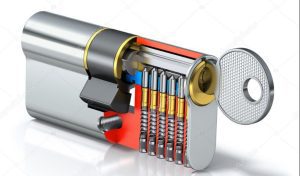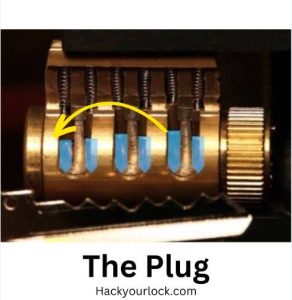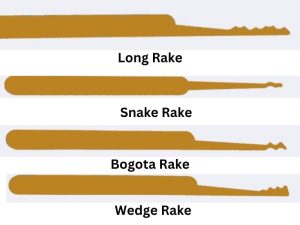Are you ready to embark on an exciting journey into the world of lock picking and learn how to pick a lock?
Excellent, because this comprehensive beginner’s guide, designed to demystify the process, has already empowered thousands of learners, and it is here to empower you too!

Despite its initial intimidation factor, lock picking— the art of successfully manipulating a lock’s mechanism—is far from rocket science.
In fact, with a little knowledge, practice, and the right set of lock picking tools, you will swiftly acquire the skills to confidently pick locks.
Prepare to discover that locks are surprisingly feeble adversaries, offering minimal resistance to those attempting to pick them.
By the time you reach the end of this guide, equipped with a solid foundation in lock picking, the ability to select and utilize the appropriate tools, and a newfound confidence, you’ll be able to tackle a wide range of locks.
No prior experience is necessary, as I’ll be your steadfast companion throughout this enlightening journey on how to pick a lock.
So, without further ado, let’s dive in and unravel the art of lock picking together, learning how to pick locks with confidence and finesse!
Contents
- 1 How to Pick a Lock
- 2 Which Lock To Choose As a Beginner – Pin Tumbler Lock
- 3 How a Pin Tumbler Lock Works
- 4 Lock Picking Tools for Pin Tumbler Locks
- 5 Techniques for Lock Picking Pin Tumbler Lock
- 6 Easiest Way to Pick a Lock
- 7 How Can You Pick a Lock Without a Key?
- 8 How Do You Pick a Difficult Lock?
- 9 How Do You Pick a Lock With a Bobby Pin?
- 10 Best Practices and Tips of Lock Picking for Beginners
- 11 Conclusion
- 12 FAQ’s
- 13 Resources
How to Pick a Lock
Before you get to know how to pick a lock, your first priority should be to decide which lock to choose for starting lock picking as a beginner.
Secondly, decide which lock picking tools are suitable for the type of lock selected.
Thirdly, grab knowledge of which techniques are suitable for the type of lock you selected for lock picking as a beginner.
After finalizing the above three scenarios, you can move on with the process of picking a lock.
Which Lock To Choose As a Beginner – Pin Tumbler Lock
The most common type of lock which is suitable for beginners to learn lock picking is the Pin tumbler lock.

Before you get to know the tools and techniques required to pick the pin tumbler locks, you must know the inner mechanism of the pin tumbler lock and how a pin tumbler lock works.
How a Pin Tumbler Lock Works
How a pin tumbler lock works is explored easily when you know all about its parts. Following is the detail about its parts.
Parts of Pin Tumbler Lock
A pin tumbler lock consists of several essential parts, including the cylinder, plug, pins, springs, and shear line. Brief overview of each component is discussed below:
1. Cylinder

The cylinder is the central part of the lock that houses the mechanism. It is typically a cylindrical casing that holds the plug and other internal components.
2. Plug

The plug is the primary rotating part of the lock. It is located within the cylinder and contains the keyway, where the key is inserted.
3. Pins

Pins are small cylindrical metal components found inside the lock. Each pin is comprised of two parts: the driver pin and the key pin. The driver pin sits above the shear line inside the cylinder, while the key pin rests below it. These pins divide the lock into the plug and the housing.
4. Springs

Springs provide upward pressure on the pins, pushing them towards the plug. They create tension and help maintain proper alignment.
5. Shear Line

The shear line is the gap between the plug and the housing. When the correct key is inserted, the key pins and driver pins align along the shear line, allowing the plug to rotate freely.
Mechanics of the lock
Understanding the various components of a pin tumbler lock, such as the cylinder, plug, pins, springs, and shear line, is essential for comprehending the mechanics of the lock and the principles behind successful lock picking techniques.
- When the key is inserted into the plug, an upward force is applied to the key pins. The key pins and driver pins in the lock have been precisely cut and aligned to match the unique bitting of the proper key. As a result, the key pins rise until they align perfectly with the shear line, causing the driver pins to fully exit the plug.
- When the gap between the key pins and driver pins matches the position of the shear line, the key gains the ability to rotate the plug, disengaging the lock.
- In essence, the key serves the purpose of removing all obstructions, represented by the pins, from the shear line. This understanding is crucial as it forms the basis for successfully picking a lock.
In lock picking, our goal is to replicate the actions of the key by manipulating the pins to achieve the same state they would be in if the correct key were inserted. By mastering this skill, we gain the ability to unlock a lock without the original key.
Lock Picking Tools for Pin Tumbler Locks
When it comes to picking pin tumbler locks, there are three primary types of tools that play crucial roles: tension wrenches, hook picks, and rake picks.
1. Tension Wrench
The tension wrench is an essential tool in any lock picker’s arsenal. It is typically an L-shaped piece of metal with a flat end and a curved end. The flat end is inserted into the bottom of the keyway to apply rotational tension to the lock’s plug.

The tension wrench is responsible for maintaining a constant and controlled rotational force throughout the lock picking process. By turning the tension wrench, the lock picker creates the necessary tension required to bind and manipulate the lock’s pins.
How to Use Tension Wrench
The tension wrench is a crucial tool in lock picking. It serves two important functions:
Firstly, it provides the leverage needed to rotate the plug and create a binding pin, which is essential for successful lock picking.
Secondly, it holds the lifted pins above the shear line, similar to how a key would.
- To use the tension wrench, insert it into the bottom of the keyway and apply gentle rotational force in the direction that the key would turn. The degree of force should be as light as pressing a key on a keyboard.
- Applying this light tension creates a binding pin, which is a key concept in lock picking. By lifting the binding pin to the shear line, the bind is broken, and the plug slightly rotates. This rotation creates a ledge where the driver pin can set, keeping it above the shear line and out of the plug.
- To determine the correct direction for rotating the plug, apply pressure clockwise and counterclockwise while observing the feel of the tension wrench. The direction that feels mushy and gives slightly is usually the correct one.
- Applying the right amount of tension is crucial. Too much tension can cause the pins to bind below the shear line, while too little tension allows the pins to fall back into the plug. Start with a slight touch and gradually increase the pressure as needed. Developing a feel for the tension wrench is a key skill in lock picking.
By understanding the role and usage of the tension wrench, you are ready to proceed with the lock picking process.
2. Hook Picks
Hook picks are one of the most common and versatile tools used in lock picking. They feature a curved or angled end that resembles a hook.

With a hook pick, lock pickers can individually lift and set the pins inside the lock cylinder. By carefully manipulating each pin, the lock picker aims to achieve the proper alignment along the shear line, allowing the plug to rotate and the lock to be opened.
Hook picks come in different sizes and variations to accommodate various lock configurations and individual preferences.
3. Rake Picks
Rake picks, also known as rakes, are specialized lock picking tools designed for rapid pin manipulation. Unlike hook picks, which focus on individual pin manipulation, rakes are used to move multiple pins simultaneously in a fast and repetitive motion.

This technique is known as raking. Rake picks have a serrated or patterned edge that allows the lock picker to swiftly and efficiently move the pins up and down inside the lock cylinder.
Raking is a popular method for quickly opening simple or less intricate pin tumbler locks.
Both hook picks and rake picks require skill and finesse to master. Experienced lock pickers develop a sense of touch and feedback from the lock to gauge the necessary movements and pressure required for successful picking.
By using a combination of tension wrenches, hook picks, and rake picks, lock pickers have the necessary tools to tackle a wide range of pin tumbler locks and employ different techniques based on the lock’s complexity and the picker’s expertise.
Techniques for Lock Picking Pin Tumbler Lock
Lock picking pin tumbler locks involves employing various techniques to manipulate the pins and successfully open the lock. Here are a few common techniques used by lock pickers:
1. Single Pin Picking
Single pin picking, also known as SPP, is a technique where each pin is individually manipulated to the correct position. This method requires precision and patience. The lock picker uses a tension wrench to apply rotational tension to the plug while using a hook pick or similar tool to carefully lift each pin to the shear line.
By gradually setting each pin, the lock picker creates the necessary alignment, allowing the plug to rotate and the lock to be opened.
How to Pick a Lock Using Single Pin Picking Technique
Let’s have a look at the steps for lock picking using single pin picking technique.
1. Apply Tension to Create the First Binding Pin
To initiate the lock picking process, insert the short end of the tension wrench into the keyway and exert light rotational pressure on the plug. Maintain this tension throughout the entire process.
2. Locate the First Binding Pin
Using a hook-type pick, push it to the back of the lock to locate the rearmost pin. Gently raise each pin and identify the one that feels stiffer and harder to move, indicating the first binding pin.
3. Lift and Set the First Binding Pin
With the first binding pin identified, carefully lift it until you feel a slight rotation on the plug or hear an audible click, indicating successful pin setting.
4. Locate and Set the Second Binding Pin
Now that the first pin is set, the lock binds on a new pin. Repeat the process by gently lifting each pin until you find the next one that feels stiff and difficult to move. Raise it until you feel rotation or hear a click.
5. Repeat the Process of Locating and Setting Binding Pins
Continue locating and setting binding pins by repeating the steps. Gradually, as each pin is set, there will be no obstruction to the shear line. Eventually, the plug will fully rotate, and the lock will open.
Congratulations! You have successfully picked your first lock!
2. Raking
Raking is a technique that involves rapidly moving the pins using a rake pick. The rake is inserted into the lock, and the lock picker applies pressure with a tension wrench.
By rapidly moving the rake up and down, the pins bounce and jostle within the lock, often resulting in some pins aligning along the shear line by chance.
Raking is a quicker but less precise method compared to single pin picking, making it effective for simpler locks with fewer pins or for initial attempts at gaining access to a lock.
How to Pick a Lock Using Raking Technique
1. Apply Tension to Create a Binding Pin
Begin by creating a binding pin, similar to previous techniques. Insert the short end of the tension wrench into the keyway and gently apply turning pressure to the plug.
2. Insert Lock Pick and Scrub the Pins
Insert the rake into the keyway and push it to the back of the lock, lifting the pins slightly. Now, perform a scrubbing motion resembling brushing your teeth.
Scrub the pins with a moderate speed, varying the angle, height, and speed of your pick during the process.
If the lock doesn’t open within 10 seconds, release the tension, reset the lock, and start again. It’s common to reset the lock multiple times before successfully raking it.
Continue scrubbing the pins until the plug fully rotates and the lock opens.
If you’re still struggling to rake the lock, try adjusting the tension slightly. Remember, successful raking relies more on applying the right tension than having perfect control over the lockpick.
By following these steps, you can effectively utilize the scrubbing technique for lock picking.
3. Rocking
Rocking is a technique that combines elements of both single pin picking and raking. With a hook pick, the lock picker applies upward pressure on the pins while simultaneously using a slight back-and-forth motion.
This movement aims to set multiple pins at once by exploiting any binding or slight misalignment among the pins. Rocking can be an effective technique for locks with varying pin heights and is often used when the feedback from the lock indicates that single pin picking alone may be challenging or time-consuming.
4. Lifting and Counter-Rotation:
In some cases, pins may have security features that require additional manipulation. For example, some locks have security pins or spool pins that are designed to catch and create a false set when manipulated incorrectly.
When encountering such pins, lock pickers employ techniques such as lifting and counter-rotation. This involves lifting the pin to the shear line while applying slight rotational force in the opposite direction.
This counter-rotation helps overcome the binding caused by security pins and allows the pin to set properly.
Easiest Way to Pick a Lock
The easiest way to pick a lock is to use the fastest method of Scrubbing. Scrubbing in lock picking refers to a technique where the lock picker repeatedly applies upward pressure on the pins while simultaneously moving the pick back and forth (scrubbing) within the keyway.
This technique is used to manipulate the pins until they reach the shear line, allowing the lock to be opened without the original key.
Get to know HOW TO PICK A LOCK S.T.E.M. Kit
How Can You Pick a Lock Without a Key?
Picking a lock without a key involves using specialized tools, such as lock picks or bump keys, to manipulate the lock’s internal components.
By applying precise pressure and positioning, the lock picker aims to align the pins or tumblers inside the lock with the shear line, allowing the lock to be opened without the original key. It requires skill, practice, and a thorough understanding of the lock’s mechanism. Find out more about this here.
How Do You Pick a Difficult Lock?
Picking a difficult lock requires advanced lock picking skills and techniques. Here are some general steps and considerations when dealing with challenging locks:
- Quality Tools: Use high-quality lock picks and tension wrenches designed for the specific lock type. Having the right tools is crucial for success.
- Understand the Lock: Study and analyze the lock’s construction, security features, and potential weaknesses. Understanding its mechanism is essential.
- Patience and Practice: Difficult locks may require more time and practice to pick successfully. Be patient and keep practicing.
- Tension Control: Apply tension to the plug (cylinder) using a tension wrench, but be gentle and precise to avoid oversetting pins.
- Sensitivity: Develop a sensitive touch to feel feedback from the pins as they set. Listen for subtle clicks or changes in resistance.
- Picking Order: Start with the standard pins, and if necessary, move to security pins (spool, serrated) one by one.
- Trial and Error: Try different picking techniques and approaches, adapting to the lock’s response.
- Lighting and Visibility: Ensure good lighting and visibility of the lock internals to observe pin movements accurately.
- Reassess and Reset: If progress stalls, release tension, reset the pins, and start again.
- Stay legal and Ethical: Always pick locks ethically and legally, with proper authorization or for legitimate purposes.
How Do You Pick a Lock With a Bobby Pin?
Picking a lock with a bobby pin is a skill often portrayed in movies and TV shows, but in reality, it’s much more challenging and unlikely to work on most modern locks.
Lock picking is a complex skill that requires specific tools and expertise. However, I can describe the basic concept of using a bobby pin for educational purposes.
To attempt lock picking with a bobby pin, you would need to fashion it into a rudimentary lock pick and tension wrench. Straighten one end of the bobby pin to create a hook-like shape, resembling a pick. The other end can be slightly bent to form a tension wrench.
Insert the tension wrench into the bottom of the keyway to apply slight rotational pressure in the direction the lock turns to open. While maintaining tension, insert the makeshift pick into the top of the keyway and gently manipulate the pins, attempting to find the binding pin or pins.
Unfortunately, bobby pins lack the precision and durability needed for effective lock picking, especially for modern locks with security features. Professional lock picks have specific shapes, sizes, and materials optimized for the task.
Moreover, lock picking is a skill that requires extensive practice, knowledge, and understanding of different lock types. Attempting to pick a lock without proper authorization is illegal and unethical.
If you find yourself locked out, it’s best to seek the assistance of a licensed locksmith to avoid potential legal issues and damage to the lock.
Best Practices and Tips of Lock Picking for Beginners
- Choosing the right locks for practicing lock picking is essential for beginners. It’s recommended to start with simple pin tumbler locks with standard keyways and fewer pins. These locks are easier to manipulate and understand, fostering better progress. Avoid advanced locks with complex mechanisms, as they can be frustrating and hinder learning.
- Using a lock picking set with various pin tumbler locks of progressive difficulty can be beneficial. Gradually challenging yourself as skills improve enhances the learning experience.
- Developing a delicate touch and tactile sensitivity is crucial for successful lock picking. Applying the correct amount of tension is key; too much or too little can impede progress. Begin with light tension and adjust until finding the sweet spot where pins respond to manipulation.
- Understanding the interplay between tension and pin manipulation is important. Pay attention to feedback from the lock, such as clicks or movements, indicating progress in aligning the pins.
- Practice is vital for honing skills. Start with simpler locks and progress to more challenging ones, refining technique and perception. With patience and perseverance, lock picking proficiency will improve, enabling precise navigation of lock mechanisms for successful picks.
- Lock Picking: A Beginner’s Guide to Covert Entry by JORDAN SMITH, Practical Lock Picking: A Physical Penetration Tester’s Training Guide By Deviant Ollam and The Complete Book of Locks and Locksmithing By Bill Phillips, 2005 are good guides to go through and read for grabbing good knowledge in lock picking.
- Remember, lock picking is a skill that should be used responsibly, with a deep appreciation for ethical considerations and a commitment to abide by the laws of your jurisdiction.
Conclusion
In conclusion, learning how to pick a lock can be a fascinating journey that opens up a world of possibilities and challenges. By acquiring the necessary knowledge, practicing the techniques, and using the right tools, you can develop the skills to overcome the intricacies of pin tumbler locks.
So, if you are ready to embark on this exciting journey, equip yourself with the knowledge, tools, and ethical understanding to responsibly explore the world of lock picking. Unlock your potential and discover the art of picking locks.
FAQ’s
Can I use lock picking to unlock my own property?
If you are the legal owner of the property and have the right to access it, lock picking can be used as a method to regain entry if you are locked out.
However, it’s important to note that picking locks without proper training or experience can potentially damage the lock or the door. In such situations, it’s often recommended to contact a professional locksmith for assistance.
Can lock picking be used for illegal activities?
While lock picking itself is a skill with legitimate applications, it’s important to emphasize that using lock picking for illegal activities is both unethical and illegal.
Lock picking should never be used to gain unauthorized access to someone else’s property, commit theft, or engage in any other illegal activities. It’s essential to use your knowledge and skills responsibly and respect the law and the rights of others.
Are all locks easy to pick?
No, not all locks are easy to pick. The difficulty of picking a lock depends on various factors, including the lock’s design, security features, and the skill level of the person attempting to pick it.
Some locks, especially higher-quality ones with advanced security mechanisms, are much more challenging to pick and may require specialized tools and advanced lock picking skills.
Resources
- Practical Lock Picking: A Physical Penetration Tester’s Training Guide By Deviant Ollam
- The Complete Book of Locks and Locksmithing By Bill Phillips · 2005
- Practical Lock Picking A Physical Penetration Tester’s Training Guide By Deviant Ollam
- Picking Locks with Audio Technology By Paul Marks
- Lock Picking: A Beginner’s Guide to Covert Entry by JORDAN SMITH
- How to Open Locks with Improvised Tools Practical, Non-Destructive Ways of Getting Back Into Just about Everything When You Lose Your Keys By Hans Conkel · 2001
- HOW TO PICK A LOCK S.T.E.M. Kit
- How to Pick a Lock for Beginners: The Tech and Tools of the Trade
